It’s odd for a vehicle to be a coupe on the driver’s side while offering two doors on the other. I explored this distinctive feature, among others during my week with the Hyundai Veloster Rally Edition.
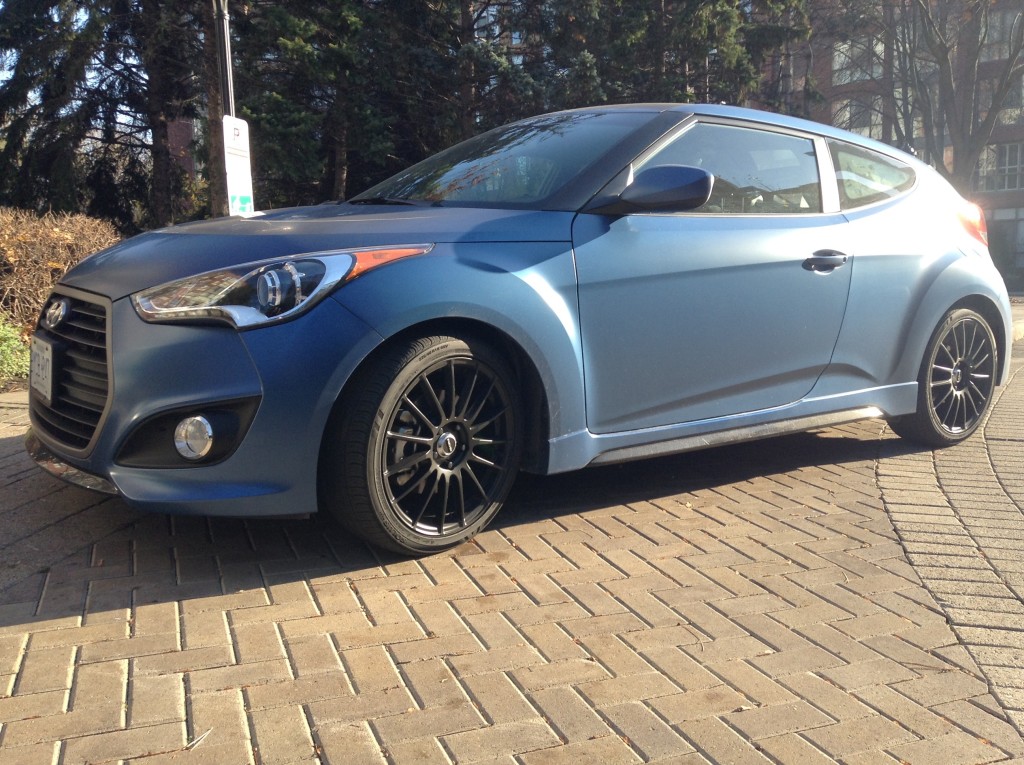
First impressions
The matte blue paint job stands out because of its dullness, if that makes sense. Matte paint is becoming a thing among carmakers. It has its proponents and detractors, but for now, it certainly is distinctive on the road.
It’s distinctive among Velosters, since Hyundai reserves the matte blue to the Rally Edition. The package of manuals includes a Matte Finish Paint Owner’s Guide, a brief guide that explains the intricacies involved in caring for matte paint. The Hyundai representative who handed me the keys took no chances; he asked me to not take it through a car wash.
(Note: I took photos of the Turbo interior from Hyundai’s site, which is essentially identical to that of the Rally Edition except for the colours – substitute blue for orange throughout this blog post.)
The Veloster’s front end is dominated by a massive gaping grille. 18” RAYS alloy wheels stand out “darkly” under muscular wheel arches. The Rally Edition is just a touch longer and wider than the base Veloster.
Hyundai scooped out bits of the rear end just under the hatch opening, next to the inside edges of the rear lights. Two exhaust tips protrude slightly from the centre of the rear fascia.
About the doors
Rear seat passengers enter the rear seat from the passenger side only, since there’s no rear door on the driver’s side. The driver’s side door is a little longer than the front passenger door.
This is a little inconvenient if you want to hang a jacket over the rear passenger seat or if you need more access to the rear seat, but otherwise this design choice doesn’t affect drivers or passengers much.
Interior
Hyundai added a sporty feel to the cabin. The door handle grips, grips flanking the shift knob and accents on the sides of the heated leather seats match the exterior matte blue paint. Those seat accents read “Turbo” since the Rally Edition and Turbo both ship with a turbocharger.
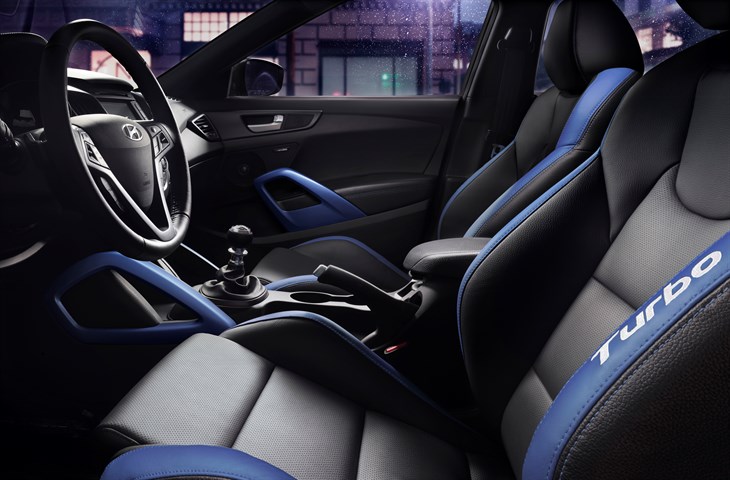
photo courtesy Hyundai Canada
The numbers on the short-throw Ð B&M Racing® Sport Shifter are capped by clear glass, encasing the shift travel in a snow-globe effect.
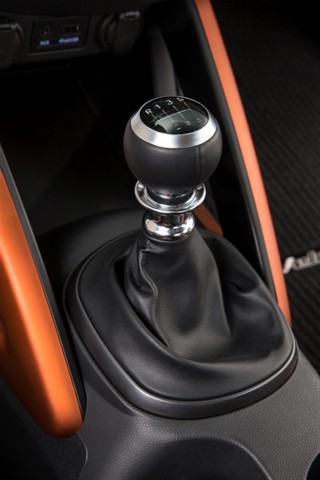
photo courtesy Hyundai Canada
Three alloy pedals stand out from the dark “Rally Edition” floor mats. The accelerator is a full-length and -width design.

photo courtesy Hyundai Canada
To start the car, you insert a key in an opening on the steering column and turn the key. This sounds like a pedestrian detail, but I was expecting a start/stop engine button in a car fitted with a turbocharger and the “Rally Edition” badge.
Cargo room is great if my hockey bag is any indicator. The bag fit easily into the hatch with a little room to spare at both ends. I didn’t need to fold down the rear seats.
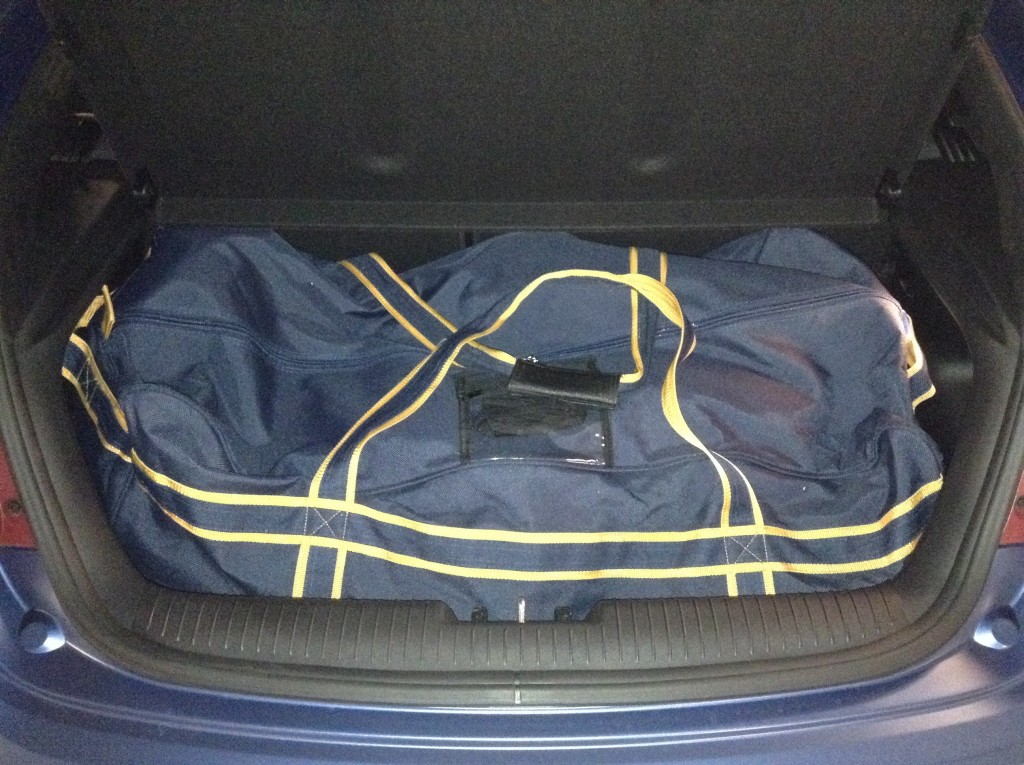
In-car technology
The Veloster ships with a 7-inch touchscreen that runs the 450-watt 8-speaker Dimension sound system and phone connection system. (Hyundai doesn’t offer its navigation system on the Rally Edition.)
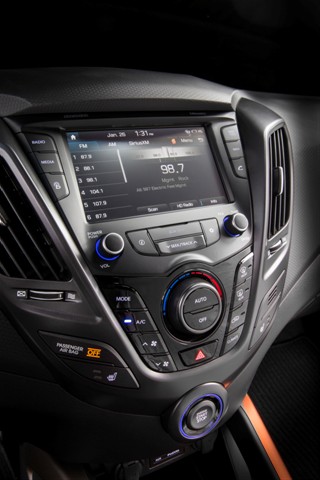
photo courtesy Hyundai Canada
When you first start the engine, the system plays a short clip of electronic music. It isn’t unpleasant, but I did consider turning it off.
For some reason, Hyundai included something that puzzle me. I’ll quote it directly from the press release:
With video games being an important element of entertainment, Hyundai integrated an RCA cable and an available 115-volt power outlet in Veloster to support gaming consoles for ultimate gaming sessions or to watch videos on the seven-inch multimedia touchscreen when the vehicle is parked.
Uh… really? I understand the looks of this car may appeal to the younger, tuner-bike crowd, but in this era of massive home theatre TVs, I somehow doubt drivers will hang out in their Velosters to play video games on, of all things, a seven-inch screen.
Individual settings are configured using a screen that resides between the speedometer and tachometer.
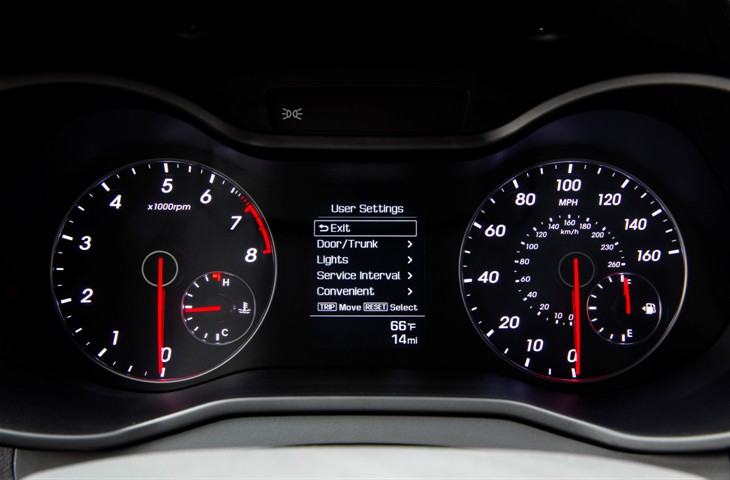
photo courtesy Hyundai Canada
Hyundai includes a CD-ROM with the owner’s manual to explain the AV system and the the navigation system. Again, in an era where increasing numbers of people use tablets (or computers that don’t have optical drives) as their primary computing devices, Hyundai might be better off publishing a link to the PDFs of the manual (which was all my Mac could read from this disc.
Driving
No sooner did I pick up the Veloster than I took it for a lengthy highway drive. It behaved quietly the whole way out and back, a comfortable cruiser in which the only hint of “performance” was the occasional bump felt through a sport-tuned suspension.
The Rally Edition ups the horsepower on the Veloster’s 1.6L Gamma gasoline direct-injection (GDI) engine from 132 to 201, thanks to the aforementioned turbocharger. Maximum torque also gets a bump from 120 lb-ft to 195 lb-ft. Acceleration is adequate, if not neck-snapping, from a standing start, as is engine noise when you step on it. I had no problem gaining a position off the line from red lights when I needed to.
Did I say the Veloster is a quiet car for the most part? Hyundai “pipes in” engine noise using Active Sound Design, probably to please drivers who want the sonic experience to match the power they’re controlling.
Shifting through the six forward gears is a silky smooth experience. The short-throw shifter slides easily and quickly from gear to gear.
The ride can be a little stiff thanks to a performance-tuned suspension, but I’ve ridden in vehicles tuned for autocross that were much bumpier.
Hyundai throws in several technologies meant to keep drivers moving in a straight line, including Vehicle Stability Management that triggers two other systems – Electronic Stability Control and Motor-Driven Power Steering – when necessary.
Fuel economy
Hyundai posts claims of city/highway/combined of 9.4 L/100 km,7.0 L/100 km and 8.3 L/100 km respectively. The Veloster takes regular unleaded in its 50L fuel tank.
Pricing
The Veloster Turbo Rally Edition, available only with a 6-speed manual transmission, starts at $26,999 MSRP.
Conclusions
Hyundai announced plans to follow in the footsteps of several Japanese companies and create a higher-end brand called Genesis. The Genesis models Hyundai already sells are well -reviewed thanks to the company’s continued focus on value for money. That focus formed my overwhelming impression of the Veloster, a quick, comfortable, practical car for the money.